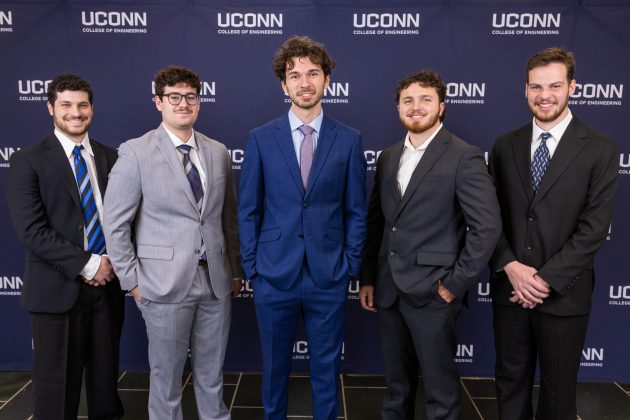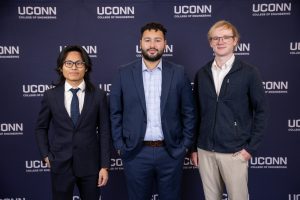Overcoming Engineering Challenges Was No Problem for This Student Team
Senior Design Demonstration Day is a pivotal day for graduating UConn Engineering students. It is where students can show the knowledge and skills they have acquired during their time at UConn through practical, real-world engineering applications.

One specific team was tasked with designing, building, and testing an unmanned electric hydroplane, with the end goal being to compete in ASNE’s 2025 Promoting Electric Propulsion (PEP) Competition. The objective of the competition included completing a 2-mile-long course at a minimum speed of 10 MPH, along with optimizing the boat for a payload of at least 30 pounds.
The joint team consisted of students from the mechanical engineering department and the electrical and computer engineering department and was sponsored by the American Society of Naval Engineers (ASNE), aided by ASNE advisor Michael Briscoe.

ME04 was comprised of students, Noah Hyman, Ian Pichs, Aldin Sabovic, Christopher Capozzi, and James Arnold and was advised by faculty Chang Liu. ECE13 included students Xingyu Qiu, Joshua Colon, and Thomas Clark and was advised by faculty Ashwin Dani.
“This senior design project gave me hands-on experience solving real-world engineering challenges through teamwork and collaboration,” said Arnold. “I was also able to forge valuable connections with industry professionals.”
Arnold was able to strengthen these connections, and recently received a post-grad offer of employment from General Dynamics Electric Boat. He’ll work as a systems engineer in the overhaul and repair engineering department.
The team said they were excited to take on this challenge. After reviewing where the 2023-2024 year’s team experienced difficulties, the team evaluated new propulsion systems and hull designs. They also researched batteries, motors, and cooling systems to mitigate various points of failure.
“A major part of this project included working with underclassmen,” said Pichs. “We were able to pass down our knowledge about electric propulsion systems, hull design, and nautical operational systems to them.”
When it came time to design their boat, the team opted for a J-class racing hydroplane, focusing on robustness to help ensure they completed the course. They chose a battery with increased capacity to account for added weight and suboptimal surface conditions, along with a higher performing motor. The cooling system they designed was minimal, helping to reduce points of failure or leakage.
As the team was gearing up for the April competition, they ran into some issues, mainly the weather. With inclement weather taking over New England, the team was only able to complete two full-system tests prior to leaving for the competition down in Virginia Beach.
During one of their tests, water intruded into the hull, shorting one of the most critical electrical components in the boat, the electronic speed controller (ESC). With limited time, the team needed to act fast and source a replacement.
Just one day before leaving, they secured a less powerful, air-cooled ESC.

During the qualifying lap for the competition, the team faced even more problems. They struggled to see the motor’s steering direction and the replacement ESC overheated due to increased load on the boat.
While the team qualified for the race, they had some serious issues to address prior to race day.
The team regrouped and put their heads together to come up with fast, innovative solutions.
To address their lack of visibility when steering the boat, the team opted to tape color-coded cardboard fins to either side of the motor. This allowed the team to easily see the steering direction.
The overheating of the new ESC posed a larger, more complex issue. Realizing that traditional air- or water-cooling could lead to further water damage inside the electronics bay, the team came up with an innovative solution… dry ice. The team realized they could pack the dry box with dry ice for cooling and silica powder to control moisture buildup.
The students split up into two teams; the first team addressed the steering issue, installing the color-coded fins to the motor; the second team sourced the dry ice they needed to pack the dry box with.
“Working on this project opened my eyes to how important it is to not give up when something goes wrong,” said Hyman, who is also now employed by General Dynamics Electric Boat. “There are always different ways to solve a problem.”
With both teams completing their tasks, the team was able to launch their boat at the start of the competition. Albeit, anxiously waiting to see if the quick fixes would hold up for the duration of the 2-mile course.
The team’s innovative and quick-thinking solutions paid off. They completed the course in 34 minutes, maintaining over 80% of the boat’s battery capacity, despite having a 60-lb payload.
“As Vice President of the Electric Boat Club, it was incredibly rewarding to see our team push through setbacks with creative solutions,” said Capozzi. “Whether it was sourcing parts last minute or coming up with dry ice cooling the night before the race, we proved what hands-on engineering and teamwork looks like at UConn.”
While they weren’t the fastest in the competition, the team left proud of their accomplishment and honored to represent UConn Engineering.
The ECE team placed first among the department’s teams in the Senior Design Demonstration Day student competition.
Post-Graduation Plans
The Senior Design program fosters and rewards student development. The process starts by working with a potential employer. Students are exposed to products, engineering practices, and the company sponsor’s culture, allowing them to assess their potential fit in the workplace. By having real-world engineer responsibilities for two semesters, students improve their marketability in the workforce. They demonstrate their success on Senior Design Day, graduate, and then leave UConn ready to serve as fully-qualified engineers.
Hyman and Arnold are now working at General Dynamic Electric Boat. Colon now works at Siemens as a building automation controls system specialist. Capozzi said he is exploring job opportunities in design and manufacturing in the naval and aerospace industries. Pichs, Sabovic, Qiu, and Clark were unavailable for a comment about their post-graduation plans.
Latest UConn Today
- UConn Entrepreneur Aims to Revolutionize Men’s Health CareReza Amin’s Bastion Health creates virtual, confidential, progressive approach to medical screening to help save lives
- UConn’s Sir Cato T. Laurencin Recognized as Springer Nature Editor of DistinctionSir Cato T. Laurencin, MD, Ph.D., K.C.S.L, has received a 2025 Springer Nature Editor of Distinction Award. The award is given to exceptional editors who have demonstrated commitment to upholding scientific accuracy and advancing discovery.
- UConn Health Minute: Two Lives, One TeamAn expectant mom learned she suffered a life-threatening condition. But the high risk pregnancy team at UConn Health had the expertise to keep mom safe as she delivered a healthy baby.
- Beautiful Moments: SFA Alum Brings Smiles to Bridal Couples with Live Event PaintingWhen Erin Leigh Boughamer '94 (SFA) left UConn three decades ago with a degree in graphic design from the School of Fine Arts, event painting hadn’t yet become part of bridal vocabulary. To ask her back then if she foresaw herself with a wardrobe of dressy pantsuits, each with at least a little dollop of acrylic paint on them, she’d have said no way
- Kumar Venkitanarayanan Named Interim Dean of UConn’s College of Agriculture, Health and Natural ResourcesVenkitanarayanan is a leader in the field of egg and poultry meat safety and has served in several leadership roles within the University
- Podcast: Angst Over Additives in Our FoodDr. Rebecca Andrews, UConn Health primary care physician, offers perspective on food dyes and other ingredients that aren’t naturally occurring













